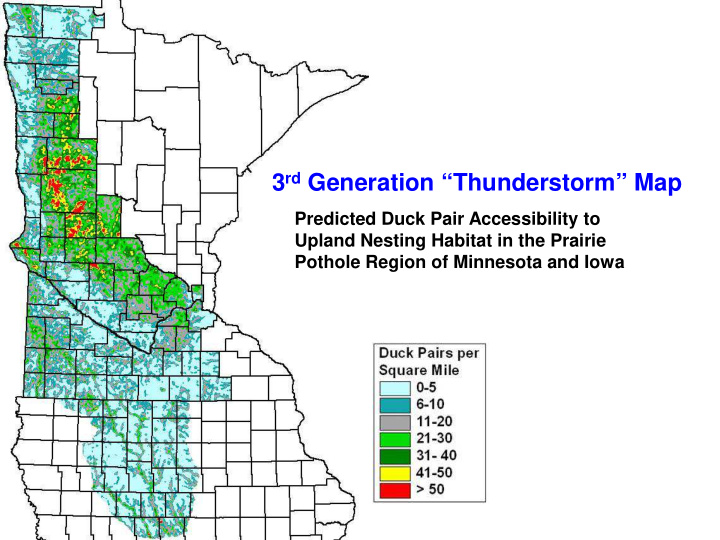



3 rd Generation “Thunderstorm” Map Predicted Duck Pair Accessibility to Upland Nesting Habitat in the Prairie Pothole Region of Minnesota and Iowa
Grassland Bird Conservation Areas
Wetland Reserve Program rankings for the MN River watershed (20 = highest) Developed to identify wetland and grassland restoration priorities, based on a compilation of: -5 waterfowl species -9 shorebird species -9 grassland bird species -1 waterbird species
Status of the Restorable Wetlands Inventory Mapping Completed 2001 - 2008 Comp Co mpleted t to Date Analyzed Area: 28,020 mi² Funded Work Area: 6,570 mi² LCCMR has provided nearly $500,000 over last 2 years Completed In Progress Goals ls f for Inv Invent ntory Analyzed Area: 32,500 mi² Counties: 47
MN DNR-delineated “Lakeshed” – Darker blues indicate more water accumulations at that point (flow accumulation grid)
To create flow accumulation grids, you must first use a topographic model of land surface and map surface run off pathways (generally also followed by tiles and ditches
Continue to make flow paths more and more refined
Until flow paths indicate where every 2 acres of the lakeshed sends its runoff
Flow networks created from flow accumulation grid with NWI wetlands (blue) and restorable wetlands (gray)
Based on information compiled in Predation Management Review. Raccoon Homeranges Females ~4 sq. miles Males ~9 sq. miles Avg. 6.2 sq. miles • Key Habitats – Riverine – Riparian areas – Seasonal wetlands – Semipermanent wetlands – Forested/Shrub Scrub wetlands – Woodlands
Landscapes for Upland Sandpiper, Hudsonian Godwit, Dunlin, and White-rumped Sandpiper during Spring Migration Average slope Percent grass Percent palustrine (ln) Proportion of temporary and seasonal
Predicted pairs/40 ac for 6 species (combined) Additional models: •CCSP •WEME probability of use
CRP and Grassland Birds Without With CRP % lo loss CRP Grass >1 ha 863,263 711,846 17. 17.5 Bobolink 888,863 626,152 29. 29.6 Clay-colored Sparrow 247,717 153,462 38. 38.1 Grasshopper Sparrow 198,298 128,308 35.3 35. Savannah Sparrow 559,044 366,324 34. 34.5 Sedge Wren 730,540 502,674 31. 31.2 Le Conte’s Sparrow 261,169 123,973 52. 52.5
MN Prairie Landscape Conservation Plan Core Areas: • Large 5,000 to 300,000 acre landscapes (36 in total) that retain some features of a functioning prairie landscape and include 73% of Minnesota's remaining native prairie • Function as a habitat base for wildlife species needing large areas of natural habitat • Goal: reach 40% grassland and 20% wetland coverage within each Core Area Corridors: • Linear stretches of habitat 6 miles wide that connect Core Areas to each other and moderate the effects of a highly fragmented landscape • Function as dispersal corridors that allow an exchange of individuals and genetics between populations • Goal: 10% of each square mile in the Corridor be protected grassland and wetland habitat Corridor Complexes: • 9 square mile habitat complexes established every 6 miles within the Corridors • Function as habitat "stepping stones" for mobile wildlife species within the Corridors • Goal: reach 40% grassland and 20% wetland within each Corridor Complex Agricultural Matrix: • All the remaining area of the Prairie Region outside of Core Areas, Corridors, and Corridor Complexes (21.7 Million Acres) • Function as habitat for species adapted to live within an agricultural countryside • Goal: reach 10% perennial native perennial cover within each Ecological Landtype Association
Recommend
More recommend